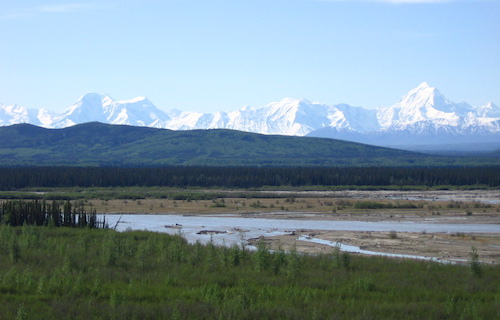Senator Murkowski Remarks: 2013 EIA Energy Conference
(As Prepared) Good morning, and thank you, Adam, for that kind introduction. It is a true pleasure to be here. At this early hour I’m reminded of advice the English poet William Blake once gave: “Think in the morning. Act in the noon. Eat in the evening. Sleep in the night.” We’re off to a good start, aren’t we?
I love gatherings like this – the world’s leading experts coming together to discuss the world’s most interesting topics with incredible breadth and depth.
As the Ranking Member of the Senate Energy and Natural Resources Committee, I know that it’s not an exaggeration to say that the Energy Information Administration is the go-to source for much of reliable and nonpartisan data we need each and every day.
Take, for instance, my Energy 20/20 blueprint, which I released back in February. One of the things I’ve heard most frequently about it is praise for the research that went into the document. It contained more than 100 footnotes – a full third of which cited EIA data or analysis.
It’s no accident that my Energy 20/20 report focuses extensively on the topic we are here to talk about today – the role of the United States in global energy markets, which is rapidly evolving.
Let’s start with our domestic situation, which is shaping up to be an unexpected success story. Record-breaking levels of crude oil production, an abundance of natural gas, newfound wealth flowing into communities that desperately need it, high-skilled jobs that pay well – the list of economic benefits to our nation is endless, and only just beginning.
People often ask, “If this oil boom is so great, then why have gasoline prices not come down?” As an Alaskan, where we have some of the highest fuel prices in the nation, I certainly feel their concern – but imagine where prices would be without our oil boom.
The National Intelligence Council, which is in charge of the intelligence community’s long-range analysis and forecasting, describes the prospect of U.S. energy independence as a “tectonic shift.” It’s right up there with the aging of the world’s population, the rise of a global middle class, and the worldwide growth of cities. That is the scale of change we are talking about.
The fundamental shift below ground has already occurred. It’s geological – we now have the technology to economically access resources we couldn’t get to before. The domestic challenge we face is that the accompanying shift above ground isn’t keeping pace. The problem is psychological. Many of us grew up in an era where energy was thought to be scarce, with the development of alternatives viewed as our only path.
Today we have a far more promising option: an “all of the above” energy policy. Through that policy we can produce more of all of our resources, we can continue to foster innovation, and we can continue to find new ways to conserve energy. And that’s why you’ve seen the Energy Committee report a number of bills to the full Senate on a bipartisan basis. That includes the efficiency bill authored by Senators Portman and Shaheen, and two hydropower bills that will facilitate more of that clean, renewable resource.
I’m also an original co-sponsor to the MLP Parity Act spearheaded by Senator Coons of Delaware. Currently the tax code provides a special structure to oil and gas companies that enables them to raise capital more efficiently, and I believe we should give all renewables – a growing component of our energy supply – that same opportunity.
Abundant energy at home means that we have a real opportunity to greatly enhance our nation’s global posture in energy markets. We already export a great deal of energy – 11.5 quadrillion Btu’s last year, according to the EIA. Coal exports have more than doubled since 2009. Natural gas exports have tripled in the past decade. And we’ve become a net exporter of petroleum products, thanks to our world class refineries.
The debate over exports of liquefied natural gas has drawn a great deal of attention. My colleague on the committee, Chairman Ron Wyden of Oregon, and I collaborated on a series of natural gas roundtables last month, one of which focused on LNG exports.
The intensity of the debate is interesting because, to me, deciding to export natural gas should be easy. Either we will have a surplus that can be sold abroad or we won’t. If we do, we can add LNG exports to the record levels of natural gas we’re already exporting via pipeline to Mexico. Those levels, by the way, are larger than the capacity of the most recently approved LNG export project. And if we don’t end up with a surplus, then we won’t see large levels of LNG exports anyway because the economics won’t make sense.
The more complicated debate will be over crude oil exports. We won’t see it this summer, but we will see it soon. And if we don’t handle LNG exports in the right way, with sensible data-driven analysis, then there is little hope we will be able to tackle a hot-button issue like crude oil in a way that escapes the din and strife of partisan squabble.
Now, looking further out to the future, methane hydrates and oil shale are two other areas that hold great potential to add to our nation’s resource base. At the moment, there are technological challenges – but we figured out oil sands, we figured out tight oil and horizontal drilling, we figured out hydraulic fracturing. If our past history with research and development is any indicator, eventually we’ll find an economically feasible way to harness the energy potential of these promising resources.
If we zoom out slightly, we see that North America, not just the United States, is in the midst of an energy revolution, too. Our friends in Canada, through determination and ingenuity, are developing oil sands in Alberta. The Canadians are also producing lots of natural gas and have already started approving their own export licenses.
Our national systems are so intertwined that the Congressional Research Service says the United States and Canada are “joined at the well.” But the relationship is not without conflict. We’ve taken far too long to approve the Keystone XL pipeline. The economic argument is obvious, but we shouldn’t downplay the diplomatic significance of this, either.
I also support the Trans-Boundary Agreement with Mexico. I think it’s important that we move forward on that quickly so that development can get underway.
But it’s not just the North American continent that holds enormous potential. Our friends in Colombia and Brazil have tremendous oil resources and are developing them to the benefit of their nations. Argentina has been blessed with some 800 trillion cubic feet of shale gas resources, according to the EIA’s latest global shale report, and 27 billion barrels of shale oil.
It seems to me there is the prospect of not just U.S. or North American energy independence, but perhaps something the whole Western Hemisphere can share in.
Zooming out to look at the entire globe, we see that North and South America are not the only areas where we have opportunities for international collaboration. Last month I visited Sweden for a meeting of the Arctic Council. It was an exciting time and the Arctic is an exciting place, and not just for Alaskans. Observers from countries like South Korea and Singapore attended alongside Scandinavians, the Russians, and others. Those nations want in on Arctic resources because they know how big the resource potential truly is.
Of course, you can’t have a say in the conversation if you don’t have a seat at the table. That’s why we need to be involved with the Arctic Council, to ratify the Law of the Sea Treaty, and to move forward on LNG exports, so our allies can diversify their energy supplies.
Our hydrocarbon boom is having ripple effects around the world. Even OPEC is studying the impact of U.S. tight oil production.
We’re talking about displaced imports, competition for refining capacity, new kinds of contracts and trade routes, and the untold effects of all of this that will reverberate through the old international system. Nor are the geopolitics of gas necessarily the same as the geopolitics of oil. For starters, there is no global gas cartel. On the other hand, oil doesn’t need costly liquefaction and regasification facilities to be traded and shipped around the world.
The only thing we know for sure is that we don’t know exactly how this will all play out. That is why the United States should not turn its back on the world when it comes to exporting energy products. We must be involved in the world markets if we are to benefit from them, and strengthen our alliances and global posture in the process. But this is also why the federal government must implement policies that provide predictability when it is needed and flexibility when it is required.
Finally, let me say a special word about EIA Administrator Adam Sieminski. Whenever one of my fellow senators on the committee asks him a question at a hearing or a roundtable, we all listen to his answer. He should be recognized for his competence and intellectual honesty. With Adam at the helm of EIA, and Secretary Ernest Moniz running the Department of Energy, I think we all have reason to be optimistic about the work we can do together. Or, as William Blake would say, to “act in the noon.”
I’ve enjoyed this chance to “think in the morning” with you and look forward to your questions.
###








